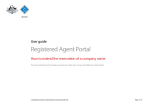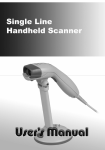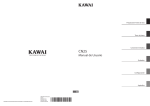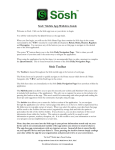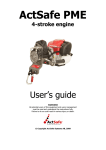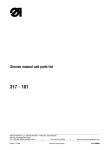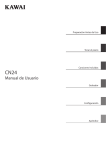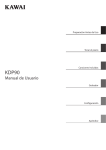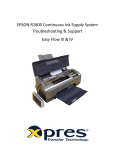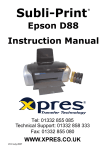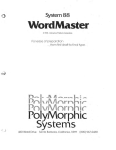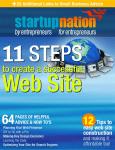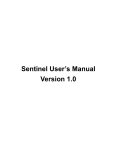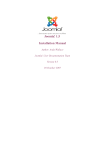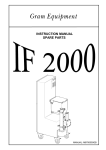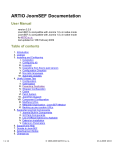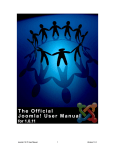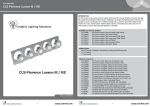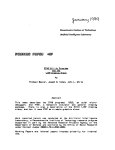Download Editorial Style Guide v1.0.5
Transcript
Editorial Style Guide
Joomla! User Documentation Team
Version 1.0.5
19 June 2007
Andy Wallace
Acknowledgements & License
License
This document is released under the Creative Commons Attribution-NonCommercialShareAlike 3.0 Unported license.
Acknowledgements
I would like to pass on my thanks to the following members of the User Documentation Team
for their efforts of proof reading and ideas on this document:
Chad McKissick
Leandro Bergantiños
Brian Lieske
Thanks
Andy Wallace
Change Log
Change
Date
v1.0.5 Updated W2W
19 June 2007
By
whom
AW
Table of Contents
What it is All About .................................................................................................................... 5
The Mission Statement .......................................................................................................... 5
Purpose.................................................................................................................................. 5
The Essentials........................................................................................................................ 5
How to Use the Editorial Style Guide (ESG) ............................................................................. 6
General Guidelines for Joomla! Documenters .......................................................................... 7
Understand your Audience .................................................................................................... 7
General Principles of Documenting Joomla!.......................................................................... 8
Using Plain English in Joomla! User Documentation............................................................. 9
What Do We Mean by Plain English? .................................................................................... 9
What is the Intention of Using Plain English? ........................................................................ 9
Keep Your Sentences Short .................................................................................................. 9
Use Active Verbs ................................................................................................................. 10
Proper Use of Passives ....................................................................................................... 11
Use of 'You' And 'We' In Documentation ............................................................................. 11
Issues of Tone...................................................................................................................... 12
Do Not Be Afraid to Give Instructions .................................................................................. 13
Avoid Nominalisations.......................................................................................................... 14
So what is wrong with them?............................................................................................ 14
Use Positive Language ........................................................................................................ 15
Date, Time, Measurement, and All ...................................................................................... 16
Date Format...................................................................................................................... 16
Time Format ..................................................................................................................... 16
Time Zones....................................................................................................................... 16
Seasons and Holidays...................................................................................................... 16
Units of Measurement ...................................................................................................... 16
Abbreviations and Acronyms............................................................................................ 16
Capitalisation .................................................................................................................... 17
Numbers versus Words.................................................................................................... 18
Use Lists Where Appropriate ........................................................................................... 19
Horizontal (Inline) List....................................................................................................... 19
Vertical Numbered List ..................................................................................................... 19
Vertical Bulleted List......................................................................................................... 19
Correctness of Spelling, Punctuation, Usage, and Grammar.............................................. 20
Spelling and Usage: ......................................................................................................... 20
Grammar and Punctuation................................................................................................... 20
Rules .................................................................................................................................... 22
Rules .................................................................................................................................... 22
Summary.............................................................................................................................. 22
What to Document ................................................................................................................... 23
Help Screen Specifics.......................................................................................................... 24
Title................................................................................................................................... 24
Header Block .................................................................................................................... 24
Sections............................................................................................................................ 24
Sources ............................................................................................................................ 24
Review ................................................................................................................................. 24
General Guidelines for Proofreaders and Editors ................................................................... 25
Procedure for Proofreading and Editing .............................................................................. 25
Marking Corrections from Proofreading............................................................................... 25
Appendices .............................................................................................................................. 26
General Style Guides for Reference.................................................................................... 26
Words to avoid ..................................................................................................................... 27
Words to Watch ....................................................................................................................... 28
What it is All About
The Mission Statement
The Joomla! User Documentation Project has the aim of providing documentation to the
Users and Administrators of a Joomla! CMS with clear, concise, useful, and usable
information for the Front-end and Back-end functionality available to them.
To make Joomla! the best documented Open Source Project.
Purpose
The User Documentation Team (UDT), Editorial Style Guide (ESG) is the official reference
guide for Joomla! User Documentation that is available within the Joomla! Help Site.
There are slight variations with regard the different individual documentation types such as
Help Screens, User Manual, Administration Manual, Installation Manual, and Supported
Documentation, but the essentials are the same throughout the project. We will release
separate documents advising on document specific requirements when necessary.
Read and use this guide in conjunction with the Visual Style Guide (VSG) and Documentation
Process Guide (DPG).
Our intention in releasing these notes, together with the individual process references, is to
guide you through the requirements and standards that we are looking to inject into Joomla!
documentation.
The Essentials
Clarity:
We want to reduce the use of technical jargon in non-development documentation or,
when this is necessary, to provide an effective explanation of precisely what the
referenced items actually mean.
Consistency:
We want to standardise the written material so that all Official Joomla! Documentation
and Supported Documentation maintains a consistent style and tone.
Correctness:
We want to produce high-quality User documentation that is devoid of spelling,
grammar, punctuation, and word usage errors.
Consideration:
We want to make the content accessible and understandable to all people, including
those from different parts of the world where English is not their native language,
those with disabilities, and people from various backgrounds and cultures.
Technical Correctness and Consistency:
One of the key priorities of the UDT Documentation Project is, and will always remain
to be, the provision of technically accurate information for the Users of Joomla!. To
this end, we will always strive to ensure the same accurate information is borne
across all of our documentation.
How to Use the Editorial Style Guide (ESG)
There are a number of ways to use the ESG to assist in the writing, proofreading, editing, and
production of Joomla! documentation:
•
Read the entire guide to familiarise yourself with the standards and editorial style
issues specific to Joomla! User Documentation. This is essential if you wish to
contribute to the project.
•
If you are new to writing this type of material, or simply just as a refresher, you may
like to check out the additional resources we reference throughout the guides. These
will help you become familiar with general technical writing skills as well as
documentation processing in general.
•
As an ongoing desktop reference guide as to how to handle specific issues or words
that will arise in the normal course of preparing documentation for the project.
•
As a source document for Third Party Extension, documenters who want to provide
their documentation with a similar look and feel to official Joomla! documentation.
•
As a resource, for Developers, to assist them in the writing of tooltips and other written
elements within the software code that in turn makes the visible display of Joomla!
more user-friendly and accessible.
•
Use it in conjunction with the Visual Style Guide.
•
Use it in conjunction with the Document Process Guide.
•
Keep up to date with any changes that we announce in the UDT Forums.
General Guidelines for Joomla! Documenters
Understand your Audience
The target audience of Joomla! User Documentation has varying degrees of experience. It is
therefore difficult to present the content in a way that meets all of these levels, all of the time.
The objective should be to write the content based upon who is most likely to be looking for
information on a particular process or function and what level, in their Joomla! development,
they are likely to have reached. For example:
•
Help Screens should primarily, be aimed at new Users with little or no experience of
Joomla! nor in addition, potentially little or no knowledge of the underlying components
such as PHP, MySQL, Apache, and associated software.
•
An Administrator Manual equally has to have a basic starting point but does not need
to go over the basic functionality that a Help Screen or User manual has previously
covered except when this is necessary as a prelude to a more detailed explanation.
Typically, more material of a technical in nature will be contained in the Administrator
Manual, as a matter of necessity.
•
FAQ’s (Frequently Asked (or Anticipated) Questions) span the full range of experience
levels and technical knowledge and should be individually referenced to indicate the
level at which they are targeted.
General Principles of Documenting Joomla!
Whatever process you happen to be writing about it is essential that you try out the actual
process whilst writing, that you write the content in the correct sequence, and that your
explanation works!
•
Ensure you are using the most recent version of Joomla! at all times.
•
Whenever possible keep sentences simple - one idea per sentence.
•
Sentences should be, generally, no more than 25 words in length.
•
Use plain English whenever possible – remember, Translation Partners translate
much of the documentation we produce into many other languages – avoid the use of
complex English phrases or colloquialisms.
•
Use common words whenever possible.
•
Whenever possible, limit the explanation of each procedural step to one action using
25 words or less.
•
Provide instructions using the active tense rather than the passive tense. For example,
write explanations using task-oriented action verbs…
•
There may be exceptions to this and many of the other rules, so if you are uncertain,
double-check with another Author or Editor regarding such situations.
•
Avoid the use of vague language, unexplained technical terms, references, and any
other unexplained or out of context content.
•
Do not use ambiguous statements, personal opinion, or any other content that detracts
from the clarity of the subject matter.
•
Fully explain technical references where these are included. If necessary, refer to a
developer for clarification.
•
Make your writing more direct by removing any unnecessary wordiness and stressing
what is most important within the statement.
•
Imagine you are discussing the topic with the User across a table. If it does not sound
the same as it would in this context, then it probably needs revising.
Using Plain English in Joomla! User Documentation
Throughout this document, you will see reference to the “User”. In the context of this and all
UDT documentation, this relates to the Front-end User as well as the Back-end Administrator.
What Do We Mean by Plain English?
Plain English does not mean writing in a simplistic (or a child-like) manner. Nor does it mean
reducing the length of a document or changing the meaning or emphasis of the message it
contains just for the sake of it.
It is not as easy as some would have you believe to write documentation. It is all too easy to
over-complicate the message we are trying to give to the Users. Clear, concise
documentation does take time to produce, it does get easier with practice and support, but
there is not a quick fix here either.
We need to establish a method of writing that is efficient and user-friendly.
By using plain English, our aim is to make our documentation:
•
faster to write
•
easier and faster to read
•
get the message across to the User that Joomla! is as easy to use as we claim it to be,
and exactly how to do this, but that it does require some effort on their part
So, it's vital that we get it right as often as we possibly can.
What is the Intention of Using Plain English?
Our aim is to create our documentation, written with the end-User in mind and with the right
tone of voice, which is clear and concise.
To create documentation that is straightforward for the Translation Partners and others to
convert to their own language.
Keep Your Sentences Short
The literary world generally accepts that an average sentence length of 15 to 25 words is
about correct.
This does not mean you have to make every sentence the same length. Be dynamic. Vary
your writing by using a mix of short sentences, like the last one, with longer ones, like this
one. Follow the basic principle of only having one main topic in a sentence, plus perhaps one
other related point. You will soon quite easily develop the ability to keep to the average
sentence length.
However, at first you may still find yourself writing the odd long sentence, especially when
trying to explain a complicated point, but most long sentences can be broken up in some way.
Use Active Verbs
We want our documents to sound active − precise and user friendly, not passive - confusing
and overly technical.
Generally, there are three main components to a sentence:
•
a subject (the person, group or thing doing the action);
•
a verb (the action itself); and
• an object (the person, group or thing that the action is done to).
In the following sentence, “Chad played on the computer”:
•
the subject is Chad (he is doing the playing);
•
the verb is played (it is the action); and
• the object is the computer (it is being played).
Whilst this is a very simple sentence, there will generally be a few more words as well. “Chad,
a Joomla! User from the USA played on his computer every night after work”.
However, the subject, verb and object are still there and their order indicates that this is in fact
an active verb.
Reverse these three elements and the sentence becomes passive:
• object then verb then subject.
The computer (object) was played (verb) on by Chad (subject).
“Played” has become a passive verb here. The sentence says what is being played before it
says who is doing the playing.
You will see that in making the sentence passive, we have introduced the words, ”was” and
“by”, and the sentence has become clumsier.
The subject does not always need to be a person and the object is not always a thing!
“The computer game beat Leandro” is active but “Leandro was beaten by the computer
game” is passive.
Here are some more examples of how to turn a passive verb into an active verb.
(Passive)
The Help Screens will be completed by us soon.
(Active)
We will complete the Help Screens soon.
(Passive)
The review was completed by Chris.
(Active)
Chris completed the review.
(Passive)
The latest version was released by the Joomla!
(Active)
Joomla! released the latest version.
Using passive verbs can cause several problems:
•
they will often be confusing;
•
they can make writing more longwinded; and
•
they make writing less lively.
Proper Use of Passives
There are appropriate occasions when you can use a passive verb:
•
To prevent something sounding hostile − “The formatting of the text needs doing.”
(passive) is better (in most circumstances) than “You have not formatted the text.”
(active)
•
To avoid taking the blame (as if we would ;)) − “Mistakes have been made.” (passive)
rather than “We made mistakes.” (active)
•
When you do not know who or what the doer is − “The User Documentation Team has
been selected.”
• If it simply sounds better (Yes there will be occasions where this applies)
You should aim to make about 80 to 90% of your verbs active.
Use of 'You' And 'We' In Documentation
Our readership is likely to be the new User to Joomla! and probably, someone with little or no
technical skills either as far as their understanding of coding and other issues. We can make
the documentation more User friendly by referring to the reader as you. Whilst this may not
be what people, (authors) are used to doing; this approach may just help the User settle in a
bit more easily.
Here are some examples of this:
•
Community members must send us...
•
You must send us...
•
Joomla! will always tell Users before we...
•
We will tell you before we...
•
Further information is available from...
• You can get further information from... ·
It is acceptable to refer to the User Documentation Team and Joomla! as “we”, and there is
nothing wrong with using “we” and “I” in the same document. However, do not use “I” on
Official documents such as the Help Screens or Manuals.
Issues of Tone
It is necessary to write the documentation in as consistent a manner as possible. We will have
contributors from different continents and cultures and whose first language may not in fact be
British English with all its various nuances; by setting a few basic guidelines and having a
considered approach to these, the result should be relatively consistent.
•
Avoid making a personal statement or using your own opinion in Official
documentation.
•
Avoid humour. This has the tendency to be territorial in nature and not everyone is
going to understand that you mean something to be funny.
•
Avoid using puns, wordplay, or innuendo to make a point.
•
Avoid statements about future developments, unless you are writing specifically about
this. The documentation must focus on “what is" and not “what may be".
•
Do not use colloquial language, unnecessary jargon, culture-specific language,
gender-specific language, or condescension in the written tone. Stick to the subject
under consideration and write about the facts.
• Stick to the principles of using Plain English outlined in this document.
When you are talking to your User, say exactly what you mean, using the simplest words that
fit. This does not necessarily mean only using simple words − just words that the User will
understand. Make use of the Glossary as a reference point for definitions of common and notso-common words in use in the Community.
In the subject matter we are dealing with, technical jargon is the standard, and it is our
responsibility to ensure that we demystify it for the whole Community. You can use jargon
when writing for people who will understand the terms and phrases; it can be a useful form of
shorthand. However, try to avoid using specialist technical jargon in general, and when it is
necessary, explain the meaning of the terms used.
So in general, keep to everyday English whenever possible. Again, imagine talking to your
reader across a table.
Do Not Be Afraid to Give Instructions
•
Stop!
•
Click the XYZ icon.
• Please refer to the ABC forum.
These are all commands − officially called imperatives. They are the fastest and most direct
way of giving someone instructions.
We could write these commands in a more expansive form but this is often unnecessary to
achieve the correct result.
•
The User should be told to Stop!
•
You should click the XYZ icon.
• We would be grateful if you would refer to the ABC forum.
There always seems to be a fear of commands. The most common fault is putting “Users
should do this” or “you should do this” instead of just “do this”. Perhaps we worry that
commands sound too harsh.
Here are some examples of longwinded phrases and shorter versions that use commands.
•
You should just think of it as a complete statement.
•
Just think of it as a complete statement.
•
Writers should aim to be punchy.
•
Be punchy.
•
The topics should be split where necessary.
• Split the topics where necessary.
The last example is probably the worst because it uses a passive verb − 'should be split'.
Unfortunately, this is very common in instructions. For example:
•
The program should be uncompressed from the zip file. The contents should then be
uploaded to the web site.
•
Uncompress the program from the zip file. Then upload the contents to the web site.
Avoid Nominalisations
A nominalisation is a type of abstract noun or in other words, the name of something that is
not a physical object but a process, technique, or emotion.
Nominalisations are formed from verbs.
For example:
Verb
Nominalisation
complete
completion
introduce
introduction
provide
provision
fail
failure
arrange
arrangement
investigate
investigation
So what is wrong with them?
The problem is their use instead of the verbs they come from. Moreover, because they are
merely the names of things, they sound as if nothing is actually happening in the sentence.
Like passive verbs, too many of them can make the reading of your text hard work.
Here are some examples.
•
We had a discussion about the matter.
•
We discussed the matter. ·
•
There will be a release of the latest version of Joomla! by the Developers.
•
The Developers will release the latest version of Joomla!. ·
•
The implementation of the method has been done by the UDT.
•
The UDT has implemented the method. ·
Use Positive Language
Always try to emphasise the positive side of things, except when it is necessary for you to be
actively negative.
For example:
•
If you do not send your payment, your subscription to the Magazine will lapse.
(Negative)
•
Please send your payment so that we can ensure you receive the next issue of the
Magazine. (Positive)
Date, Time, Measurement, and All
Date Format
Dates will always be listed day as a numeric, month name in full, and the year as a four digit
numeric, without any ordinals (th, rd, st) or punctuation as in the following example:
12 June 2007
Time Format
Joomla! uses the International Standard Notation for time code for the time format in its
documentation [hh]:[mm]:[ss]. For example, 23:59:59 represents the time one second
before midnight.
Time Zones
All time zone references should be referenced against Coordinated Universal Time (UTC) –
also known as Greenwich Mean Time (GMT) or Z (zulu).
A time zone is shown relative to UTC and is displayed as UTC ±[hh]:[mm]. For example,
UTC+01:00 means one hour ahead of UTC.
Seasons and Holidays
Always write seasons as spring, summer, autumn, and winter. Note the absence of a capital
letter to start the word – a common mistake.
It would be impossible to list all the national holidays of the world as a usable reference. Deal
with these on a case-by-case basis thereby avoiding creating a national or religious conflict.
Refer to a national holiday name, followed by the country to which it refers in parenthesis.
Units of Measurement
We will use the International System of Units (SI) for measurements.
Briefly, this means the use of metre, centimetre, millimetre, for distance (dimensions, length,
and width), and grams, kilograms and tonnes for mass (weight).
For a detailed description of specific SI units, please visit: How Many? A Dictionary of Units of
Measurement a web site maintained by Russ Rowlett.
Abbreviations and Acronyms
When using abbreviations and acronyms, make sure that:
•
when they are first introduced in a document, you use the full term with the
abbreviation or acronym following it in parenthesis
•
the next time the abbreviation or acronym appears in the same document you omit the
spelled-out term
Find another way to communicate commonly misunderstood (and misused) abbreviations
such as i.e., e.g., etc. Consider replacing i.e. or e.g. with for example, etc, with and others
or and more but these are only suggestions and it depends on the circumstances.
Avoid overusing abbreviations or acronyms in a document as it can quickly become
confusing. Remember we are writing documentation for the User to read in comfort, not an
SMS message on a mobile phone!
Capitalisation
Capitalisation is a method of emphasis; refer directly to the Visual Style Guide for specific
formats to use for the text we are writing.
Capitalise in the following situations:
•
All letters in acronyms, unless the acronym is a well-known exception
•
the initial letter of the first word in a list item but only when the entry created is a full
sentence
•
the initial letter of a sentence
•
the initial letter of a complete sentence after a colon
•
to accurately replicate a key name on your keyboard, such as the Shift key, or Caps
Lock key
•
Capitalisation is an important issue with particular regard to proper names used within
Joomla! All the key components, menus, functions, and more must be capitalised. For
example, Modules, Plugins, Components, Section Manager, Site Menu, Menu Item,
Article…
•
Use the exact capitalisation style of messages shown on the computer screen, of
hardware labels, software titles, and so on.
•
Use capital letters for names of people, races, cities, regions, counties, states, nations,
languages, and other such proper names.
•
Use capital letters for titles of offices when the title precedes the name of an
officeholder but not when the title occurs alone.
•
Use capital letters for the days of the week, months, special days, and holidays—but
not for the names of the seasons:
•
Use capital letters for religions and religious groups.
•
Use capital letters for organisation names (commercial, governmental, and non-profit)
as well as their products and services:
•
Use capital letters for references to most numbered or lettered items for example:
figures, tables, chapters, parts.
•
Use capital letters for objects that have individualised names.
•
Use capital letters for most acronyms. When in doubt, check the dictionary. Use
capital letters for the spelled-out version of acronyms only if the spelled-out versions
are proper nouns in their own right.
Do not capitalise in the following situations:
•
When you want to emphasise something NEVER, use all-caps to highlight a word only
use the formats defined in the Visual Style Guide.
•
The only exceptions to this are within code extracts where it is a direct
representation of the code or when representing a screen or system message
configured in this way.
•
Variable names
•
The initial letter of the first word following a colon, if the word is part of an incomplete
sentence
Numbers versus Words
In this type of documentation, we will often use numerals in text, even those below 10,
breaking one of the established writing rules.
Do not use words, when the number is a direct representation of a specific value. For
example, in referring to Joomla! Version 1.5, the numeral is in order as it is a direct reference
to a numerical sequence (it would also look very strange written as Joomla! version one point
five). If we were to say, “There have been 2 major releases of Joomla!” this would be
inappropriate and we should in fact say, “There have been two major releases of Joomla!”.
Do not use Numerals to start a sentence. Either write the number out in words or preferably
use a different order of words so that the number occurs within the body of the sentence.
If your text includes fractions, do not use any editor specific characters as are found in most
word processor programs. Enter the fraction as 8-1/2 (eight and a half) ensure there is a
hyphen between the whole number and the fraction. However, it is unlikely that you will need
to use fractions in Joomla! documentation and you should endeavour to convert any that are
required into decimals instead.
Use Lists Where Appropriate
The Visual Style Guide explains the formatting of lists in detail.
Lists are excellent for splitting information up and adding emphasis.
Horizontal (Inline) List
There are three main types of list for us to consider here: (1) the horizontal (inline) list, (2) the
vertical numbered list, (3) the vertical bulleted list.
Use horizontal, inline lists when you need to define a list of items but emphasis is less
important.
Limit the number of items to four or five otherwise consider using a vertical list.
Vertical Numbered List
There are three main types of list for us to consider here:
1. the horizontal (inline) list
2. the vertical numbered list
3. the vertical bulleted list
Only use vertical numbered lists when you are describing a defined process that must follow a
set sequence or when you need to refer to the points within it from the surrounding text.
Limit the number of items to around seven to ten; otherwise consider grouping related items
under sub-lists.
Vertical Bulleted List
There are three main types of list for us to consider here:
•
the horizontal (inline) list
•
the vertical numbered list
• the vertical bulleted list
Use bulleted lists whenever you need a list of items to be emphasised outside of the main
text. Limit the number of items to around seven to ten; otherwise consider grouping related
items under sub-lists.
Bulleted and numbered lists must always have an introductory statement. ·
Use lowercase letters to start the listed points except when they are complete sentences
when they must start with a capital letter and end with a full stop (period).
With a list, that is part of a continuous sentence, put semicolons (;) after each point and start
each with a lowercase letter.
If you know that:
•
you have an Apache server;
•
you installed MySQL; and
• you installed PHP;
you should be able to install Joomla!.
As you can see, the next to last point has 'and' after the semicolon. If you only had to prove
one of the three points instead of all of them, this word would be 'or'.
Always make sure each point follows logically and grammatically from the introduction. For
example, if you took out 'you' from the second and third points it would still flow as a normal
sentence but not as a list. The third point would then read, 'If you know that installed PHP',
which obviously does not make sense.
Correctness of Spelling, Punctuation, Usage, and Grammar
It is essential to maintain correctness in spelling, punctuation, word usage, and grammar
when producing documentation both for online and offline use.
Spelling and Usage:
•
Remember to use the British English (en_GB) spelling of words rather than the
American English spelling.
•
Be on the lookout for words that are often spelled incorrectly (Words to Watch)
•
Check for and correct the following issues:
•
Inconsistent capitalisation
•
Inconsistent use of terminology
•
Repeated words
•
Typographical errors
•
Missing words
•
Verbs in the wrong tense
•
Emotions, desires, opinions, sense of location or dimension to an inanimate object
(anthropomorphism)
•
"The" used to begin article titles, manual titles, chapter titles, headings, figure
captions, table captions, and callouts
•
Contractions (don't, wouldn't, isn't) although these are acceptable where they
assist in making the document more readable
Grammar and Punctuation
Keep an eye out for and correct these common errors in grammar and punctuation:
• use of a slash “/” as well as using and/or
•
•
•
inconsistent use of hyphens “-“ and dashes “—“
•
hyphens are used to prevent ambiguity, with a numeral in a compound modifier,
with some standard prefixes and suffixes, in spelled-out fractions, and in variable
names of two or more words
•
do not use for industry-accepted terms, to construct verbs, with an adverb ending
in "ly", with numerals as single modifiers, with a word that that uses a common
prefix, or with trademarked terms
•
to create an introductory piece of text: use a paragraph break or a colon rather
than an em dash or en dash
inappropriate use of parentheses “()” and brackets “{}, []”
•
use parentheses to contain the abbreviation of a term on the first occurrence of
the full term
•
brackets should be used for optional command line entries, but not as a substitute
for parentheses or to indicate variables in text
incorrect use of apostrophes
•
•
•
incorrect use of quotation marks
•
limit the use of quotation marks to identify quoted speech; numbers, letters, or
words referred to as such
•
do not use single quote marks at all other than in direct representations of code
terms must be legitimate or not used
•
•
apostrophes used to denote plurals
ensure you define terms for the reader in the content itself, or in the glossary
incorrect use of comma splice
•
excess commas
•
commas used in a series of adjectives used as one modifier
•
commas between two short independent clauses
•
always use the third comma in a serial list, for instance, "the top, middle, and
bottom" rather than "the top, middle and bottom"
•
long sentences joined by conjunctions
•
long sentences with confusing subordinate clauses
•
incomplete sentences that leave out the articles
•
over-elaborate sentence structure and syntax
•
unnecessary adjectives in a phrase that could stand alone without them
•
unnecessary adverbs in a phrase that could stand alone without them
•
use of semi-colons
•
use of the colon:
•
do not be use to introduce a figure, table, heading or at the end of a procedure
introduction
•
always use to introduce a list or before an explanation
•
do not use double spacing
•
use an ellipsis ”...” to show that you have omitted something from a sentence or to
indicate a pause when you quote displayed text, do not have a space before the
ellipsis
Rules
It is not the intention to rebel against the grammatical rules in the aim of achieving good User
documentation. There are mysteries and preconceptions surrounding grammar that often
impede the writing of user-friendly documents.
•
You can start a sentence with and, but, because, so, or however.
•
You can split your infinitives. So, you can say to boldly go.
•
You can end a sentence with a preposition. In fact, it is something we should stand up
for.
•
And, you can use the same word twice in a sentence if you can't find a better word. ·
•
Of course, this does not mean you should break these so-called rules all the time −
just when they make a sentence flow better.
Summary
•
Stop and think before you start writing. Make a note of the points you want to make in
a logical order.
•
Use short words. Long words will not impress your Users or help your writing style.
•
Use Plain English whenever possible. Avoid jargon and colloquial words, and explain
any technical terms you have to use.
•
Keep your sentence length down to an average of 15 to 25 words. Try to stick to one
main idea in a sentence.
•
Use active verbs as much as possible. Say 'we will do it' rather than 'it will be done by
us'.
•
Be concise.
•
Imagine you are talking to your reader. Write in a style that is suitable and with the
right tone of voice.
•
Always check that your writing is clear, helpful, human, and polite.
•
And, always, always, make sure that what you have written works!
What to Document
One of the key factors in writing a document is the question “How do I decide on what is
appropriate to include in this Help Screen/ Manual/reference…?” There are questions that
you must answer before this one:
•
What type of document are you writing for?
•
Who are you writing this document for?
•
•
What is their anticipated level of experience with Joomla!
•
What is their expected level of knowledge of supporting programs?
What should the target audience be able to get from the information I am writing?
•
Will it add value to what already exists? (this one is more to do with proofreading and
editing)
Then ask yourself:
•
Do you have the knowledge to write the information or need to research the topic?
• Do you need additional support?
Finally, based on the answers to the previous questions …:
•
Plan a sequence and structure to the element you are writing about.
•
Consider what others have written and try to follow a similar structure, assuming that it
is correct. This is a personal interpretation issue, so discuss with others if necessary.
•
Identify whether there is already existing documentation within the Help Site/Workshop
that fits the bill and you can reuse it, there is no point reinventing the wheel every time!
•
Establish a cut-off point at which to stop writing about the topic to avoid overdoing it.
Where this point is depends on the context of the document.
This may all seem a lot to be thinking about but it will quickly become an automatic part of
your writing procedure.
Help Screen Specifics
The following are general guidelines for each of the elements of the Help Screens.
Title
•
Edit the title so that it duplicates the title of the Help Screen.
Header Block
•
The content of the Header Block is pre-established by need.
•
Edit the block for the Help Screen currently being written or edited.
•
Add external references for Further Information locations.
•
Check that all links do what we intend – this includes URL’s, anchors/links within the
current document, and links to other Help Screens, of direct relation, that are not
referenced within the main body of the text.
•
Add the correct image for the screen that is the subject of the Help Screen.
Sections
•
Identify the correct sections that you should retain or add to the basic template format.
Delete those that are unnecessary.
•
Consider the section title and what this represents and add content to each section in
turn as required.
•
Do not duplicate content that is contained within the support group of pages – Toolbar,
Mini-icons, Common Headers, Details, Parameters…
Sources
•
Do not simply copy the words of another source (outside of the Joomla! Help Sites
own content). The processes, which you are reviewing, are not copyrighted, the way in
which others have written about them probably is! This includes the Forums. Use
these resources to ensure you understand a process properly, and then put it into your
own words.
•
If you must include copyrighted material, ensure that you properly index and reference
it as such. This includes images.
Review
Once you feel a document is complete, it is important to review it and determine whether:
•
what you have written, actually explain what you intended originally
•
the processes described work
•
it is complete
•
the formatting is correct
•
the rules of this guide, the Visual Style Guide, and the Document Process Guide have
been correctly implemented
If you consider all is complete then you need to indicate this to be the final version of the
document and it is ready to be moved to the next stage – See the Documentation Process
Guide.
General Guidelines for Proofreaders and Editors
If you are simply proofreading a document, identify your corrections, comments,
and suggestions via the Comments facility in the Project Manager. Do not edit the
screen directly.
If you are carrying out a formal edit of the document, make sure it is located at the
correct stage of the overall process.
Make sure you have made a new copy of the document and that it has the correct
version number.
Procedure for Proofreading and Editing
The following are generally suggestions, as everyone will have their own ideal way of
completing the process.
•
Make several different passes through the material as you are proofreading, in order
to catch different types of issues each time through.
•
Avoid making any edits on the first pass – just make a note of any obvious issues.
•
During the first pass, look for obvious spelling, punctuation, grammar and usage
issues that jump out at you right away. You may want to review proper spelling,
punctuation, grammar and usage rules before you begin, so they are fresh in your
mind as you are proofreading.
•
During the next pass, carefully read and review the content for clarity, consistency in
style and tone, and accessibility. Ask yourself if the content makes sense, if it is written
in the best way it can be, and if anything is missing that should be added.
•
Make sure you have caught everything that needs correction by passing through the
material again and fine-tune it where needed.
•
Reading out aloud often helps you to identify problems that you missed when reading
silently.
•
Check for common mistakes, such as not completing parentheses, brackets, and
quotation marks, comma splices, dangling modifiers, and commonly misspelled words
(see Words2Watch).
•
Another suggestion to help you identify errors, especially in spelling, is to proofread
the document in reverse: from bottom to top and right to left.
•
Constantly check compliance with the Visual Style Guide and Documentation Process
Guide.
Marking Corrections from Proofreading
Copy the text that the comments apply to into the Comment facility. Then, record your
corrections, comments, and suggestions. Please follow these directions:
•
•
Please use green text for all additions and modifications, and red for any text that the
author should delete or replace.
In other words, if you are:
•
Adding extra new text - use green text
•
Deleting unnecessary text - use red text
•
Replacing existing text - use red for the text to be deleted and green for the new
text to be added
• Modifying existing text - use green text (for example, correcting a spelling error)
Post any questions, comments, or suggestions you may have to the Suggestions,
Modifications & Corrections forum.
Appendices
General Style Guides for Reference
We aim to create all Joomla! documentation using British English (en_GB) as the base
language. It is done in this way to ensure there is a single language (variant) that it is
necessary to understand - making it easier for Translation Partners and others to translate the
documentation available within the Joomla! core and the Help Site.
You can research much of what we aim to achieve by way of style, grammar, punctuation,
and general word usage in many of the available online style guides and web sites.
The following is a list (in no particular order of preference) of just a few of such sites:
•
http://www.usingenglish.com Those writers and contributors whose first language is
not English will find this site most beneficial.
•
http://en.wikipedia.org/wiki/Style_guide#International_standards This page, on the
popular Wikipedia web site, gives access to a whole raft of other resources far too
many to be listed here with any real meaning.
•
http://economist.com/research/styleGuide// The Economist Style Guide is a
representation from a book handed to all new reporters on The Economist business
journal.
•
http://www.askoxford.com/?view=uk AskOxford.com is the online presence of the
Oxford University Press – the publishers behind many language-orientated books
including; the Oxford English Dictionary.
•
Spelling differences between American and British English
•
The American-British British-American Dictionary
•
WWlib-Notes on American English
•
It is very easy to be caught up in the detail of these sites and lose to direction with regard the
documentation itself, so we will try to cover as many of these aspects as we can and add to
these guides as we find necessary.
Primarily we use the Oxford English Dictionary as the reference for all spelling aspects.
Should you find a particular reference or issue that needs adding to these guides please
notify the UDT on the forums at http://forum.joomla.org/index.php/board,62.0.html and we will
look at your recommendation and include it if appropriate.
Words to avoid
Try to use the alternatives we suggest in the table.
Word
Alternative
additional
extra
advise
tell
applicant
you
commence
start
complete
fill in
comply with
keep to
consequently
so
ensure
make sure
forward
send
in accordance with
under, keeping to
in excess of
more than
in respect of
for
in the event of
if
on receipt
when we/you get
on request
if you ask
particulars
details
per annum
a year
persons
people
prior to
before
purchase
buy
regarding
about
should you wish
if you wish
terminate
end
whilst
while
Words to Watch
Words to Watch (W2W) are words commonly misspelled or which may have variations that
depend on the Joomla! style guide choices.
An entry, which is just a word without a comment, is to show how we are spelling that word.
If an entry has something rather than something else then it should be read as, "We are
using the spelling of the first something rather than the other possible spellings shown in
something else".
Accepted Word
Unacceptable Word
Detail
accessory
Spell with a double c and a double s; the ending is
-ory.
accommodate
Spell with a double c and a double m and an o
before and after the m's.
administrator
Administrator
Always capitalise when referring to the Joomla!
User level or the Back-end Administrator. (Use of
the latter should be limited to avoid confusion.
Refer to this area as the Control Panel when
referring to the facilities and Back-end when
comparing to the Front-end.
address
Spell with a double d.
aggression
Remember to spell with a double g and a double s.
allege
Use a double l and spell with -ege at the end.
a lot
alot
Use as two words, not one.
amend and amendment
Spell with a single m at the beginning.
apologize or apologise
Spell with -olo- in the middle.
apparent
Use double p but only one r and end in -ent.
argument
Do not put an e after the u, as you would in argue.
Article
Capitalise the word Article when referring to the
element of Joomla! content.
AutoCorrect
One word with capitalisation as shown
Back-end
backend
Ensure it is always capitalised and hyphenated
when referring to the Administrator area of Joomla!
backup and back up
Use backup when used as an adjective, as in "he
had a backup disk in his bag" and use back up
when using it as a verb, as in "don’t forget to back
up your hard drive".
Banner
Capitalise the word Banner when referring to the
element of the Joomla! Banner Component.
bitmap
bit map or bit-map
One word not hyphenated or two words.
Accepted Word
business
Unacceptable Word
bisiness
comand
Always capitalise when referring to the Component
element or Manager function.
Contact (Manager)
checkbox
check-in (noun/adjective)
(Global) Check-in
check box
checkin
(noun/adjective)
concensus
controversy
Spell with -sen- in the middle.
Capitalise the word Contact when referring to the
element of the Joomla! Contact Component.
Contact
Control Panel
We will be using check-in, which must be
capitalised when referring to a specific function,
Menu Item, or button such as Global Check-in. It is
correct to use check in (verb) as in "check in your
materials".
Capitalise the word Component when referring to
an Extension in Joomla!.
Component (Manager)
consensus and
consensual
Spell with busi- at the beginning
Capitalise the word Category when referring to the
element of Joomla! content.
Category (Manager)
command
Detail
control panel
Capitalise when referring to the Joomla! Back-end
functional area.
contraversy
css
Always capitalise except in code or when a file
extension.
database
data base
One word not two
desperate
desparate
Spell desperate with -per- in the middle.
dial-up
dialup dial up
Include the hyphen between "dial" and "up".
disappoint and
disappointment
dissapoint disapoint
dissappoint
Remember to spell with one s and a double p.
eighth
eigth
Remember to use -hth at the end.
E-mail email
E-mail is obviously correct at the start of a
sentence!
CSS
e-mail
We will be going with e-mail (lower-case and
hyphenated) for consistency.
extension(s)
Refer to Components, Modules, and Plugins
collectively as Extensions. Always capitalise when
referring to CMPT’s
embbaras
Spell with a single b, double r, and a double s.
Extension(s)
embarrass
Accepted Word
Unacceptable Word
Detail
extraordinary
extrordinary
Do not omit the “a” of extra.
fascinate and fascination
facination
Spell with an s before the c.
file name
filename
Two words rather than one.
Spell with -ie- in the middle.
friend
frontend
Ensure it is always capitalised and hyphenated
when referring to the User (public) area of Joomla!
Frontpage frontpage
Always two words. Capitalise the words Front Page
when referring to the Menu Item element of
Joomla! content.
fulfil
fulfill
Spell with one l in the middle and one at the end
gateway
gate way
One word, not two.
gauge
gage
Spell with -au- in the middle.
grateful
gratful or graitful
Begin with grate-. Single ‘l’ at the end
harass and harassment
harrass and
harrassment
Spell with a single r and a double s.
hard disk
hard-disk
Two words. No hyphenation
hardware
hard-ware
One word. No hyphenation
home page
homepage
Always two words.
HTM html
Always capitalise, except in code or when a file
extension.
hypocrisy
hypocrasy hypocrisey
Begin with hypo- and end with -isy.
immediate and immediacy
imediate
Spell with a double m.
independent
independant
End with –ent rather than -ant.
instalment
installment
Spell with one l
itinerary
itinery
End with -erary.
JavaScript
javascript Java Script
One word but with the J and S capitalised.
joomla, Joomla,
Always capitalise and include the
exclamation mark every time except in code.
Front-end
Front Page front page
HTML
Joomla!
Use as the starting point to all references to
directories within the core installation to avoid
confusion with the web server or database root.
joomla_root/
keyboard
licence and license
key board
One word not two
Use licence as a noun for the permit you obtain to
Accepted Word
Unacceptable Word
Detail
do something like hunt or drive, but use license
when you mean it as a verb, to give permission to
or allow someone to do something or for something
to occur.
login, logon, logoff, and
logout
Noun always one word one “g” the act of logging
into or out of a computer or Web site.
log in, log on, and log off
log out
Verb to go through the procedure of logging in to or
out of a Web site for example
maintainence
Spell with -ten- in the middle and end with -ance.
mambot
Always capitalise when used for a Joomla!
Extension. Remember from 1.5 this is replaced by
Plugin.
manager
When referring to either the User level or a
Manager screen (Poll Manager) it is capitalised.
manoeuvre
maneuver
Spell with -oeu- in the middle and -vre at end
Media Manager
media manager
Capitalise when referring to the Joomla! function.
menu
When referring to a specific menu in Joomla!
always capitalise.
menu item
Two words and capitalise both when referring to
the specific element within Joomla! but not when
generally discussing any old menu items
meta data
One word
maintenance
Mambot
Manager
Menu
Menu Item
metadata
millennium
Spell with a double l and a double n.
minuscule
Spell with a u after the n.
mispell
Spell with a double s.
module
Always capitalise when used for a Joomla!
Extension.
multitasking
multi-tasking multi
tasking
one word
MySQL
mysql MYSQL
misspell
Module
newsfeed Newsfeed
Always capitalise when referring to the Component
within Joomla!, and always two words. Manager
when included is always capitalised
necessary and necessity
neccessary
Spelled with one c and a double s.
occasion
occassion
Spell with a double c and a single s.
OK
Ok, ok
capitalise both letters
News Feed (Manager)
Accepted Word
Unacceptable Word
Detail
omission
ommission
Spell with one m and a double s.
online
on-line on line
One word
Open Source (OS)
open source
Capitalise the O and S.
Spell with an i before and after the g.
original
overwrite
over write over-write
One word
password
pass word
One word
php
Always capitalise except when used as a file
extension or in code
poll manager
Always capitalise when referring to the Component
in Joomla!.
PHP
Poll (Manager)
platform
One word, always capitalise when referring to the
Extension.
Plugin(s)
possess and possession
posess
Spell with a double s before and after the e.
PostScript
Post Script post-script
One word. Capitalise P and S.
Use practice as a noun when describing actually
doing something rather than just discussing it or
theories about it, as in “put your good manners into
practice”. Use practise as the verb, “improving your
skill by doing something over and over”.
practice and practise
presence
presance
End with -ence.
privilege
privilage privildge
Spell with -ege at the end.
proofread
proof-read, proofed,
proof read
This applies to all derivatives as well, such as
proofreader, proofreading, etc.
questionnaire
questionare
Spell with a double n and end with -aire.
really
realy
Spell with a double l in the middle.
receive
recieve
Use i before e except after c.
recommend and
recommendation
reccomend
Spell with a single c and a double m.
restaurant
restorant restaront
Spell with -au- between the t and r.
rhythm
writhm
secretary
secratary secretery
Use an e after the r and end with -ary.
section
Always capitalise when referring to the specific
element within Joomla! cms.
Section
Accepted Word
Unacceptable Word
Detail
seize
sieze
Spell with the e before the i.
separate
seperate
Spell with -par- in the middle.
similar
simalar simillar similer
End with –lar rather than -ler.
skilful, skilfully,
skilfulness
skillfull
Watch for variations as shown
software
soft ware soft-ware
One word
source code
sourcecode
Two words
style sheet
stylesheet style-sheet
Two words no hyphen
subdirectory
sub-directory sub
directory
One word
subdocument
sub-document sub
document
One word
success and successful
sucess
Spell with a double c and a double s.
sufficient
suficient
Use a double f in the middle and end with -cient.
super administrator
Always capitalise when referring to the Joomla!
User level.
Super Administrator
surprise
Spell with an r before and after the p.
tomorrow
Spell with a single m and a double r.
toolbar
tool bar tool-bar
One word
twelfth
twelth
Spell with an f in the middle.
unfortunately
Spell with -ately at the end.
until
Use a single l at the end.
URL
User
Url url
Capitalise except when used in code.
user
When referring to a specific Joomla! User always
capitalise first letter
Spell with -icle at the end.
vehicle
Web
web
Capitalise except when using to refer to a spiders
trap!
weblink web-link
Two words unhyphenated. Capitalise the words
when discussing the Component variant - Web
Link Manager.
website Web Site web
site
As the World Wide Web is a proper noun, we use
initial upper-case letter, in the same way as you do
with your surname. This is a change. Site
Web link Web Link
Web site
Accepted Word
Unacceptable Word
Detail
however is lower case.
wierd
Spell with the e before the i
willfull willful
Only use a single l in the middle, and one at the
end.
withhold
withold
Spell with a double h in the middle.
World Wide Web (WWW)
Worldwide Web
Capitalise, as it is a proper noun. Three separate
words. Capitalise the abbreviation (except in
URL’s)
weird
wilful


































